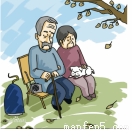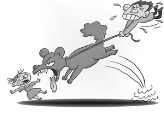题目内容
So you think you know your dog. But how well does your dog know you? She probably recognizes you when she sees you. But can a dog tell by simply looking at you whether you have a happy or an angry expression on your face? Researchers in Austria have taught pet dogs to know the difference.
Dogs are very mindful of sound. When dog owners shout or speak in a strong, unkind voice, dogs often act ashamed and quietly move away from the area.
Recently, researchers found that dogs can look at our faces, and tell the difference between a smile and a frown(皱眉). The animals were able to recognize a look of praise from one of blame.
Researchers at the University of Veterinary Medicine, Vienna performed a series of experiments. They taught dogs to recognize facial expressions. They showed the dogs two pictures of either the upper or lower half of a person's face. On one picture, the person looked happy. The other appeared angry.
The dogs were then shown images of the eyes or mouths of people they had never seen before. They were also shown the left half of the faces used in training.
Corsin Muller led the study. “We were really speaking, do they realize that smiling eyes have the same meaning as a smiling mouth, or angry eyes have the same meaning as an angry mouth? And it turned out that they really did perform very well in these research experiments.”
Once the dogs learned to recognize which image was happy or angry, they could easily find the same expressions in pictures of any face.
Corsin Muller says future studies will try to show whether dogs can learn the meaning of facial expressions―for example, whether a frown shows that someone is angry.
In the experiments, researchers found the dogs were slower to link a reward, or prize, with recognition of the angry face. This suggested that dogs had an idea people with angry faces were best avoided.
1.What does the passage mainly tell us?
A. How one can know his dog well.
B. How a dog can probably be well trained.
C. How a dog can tell one something.
D. How a dog can know one’s expressions.
2.Hearing its owner’s strong, unkind voice, a dog is likely to_________.
A. jump happily B. act excitedly
C. escape quietly D. shout loudly
3.A dog is able to recognize one’s __________.
A. praise B. blame
C. anger D. all of the above
4.What can we learn from the passage?
A. Dogs are as clever as human beings.
B. Dogs can understand man’s feelings.
C. Dogs can be trained to do everything.
D. Dogs can learn to make any angry face.
 探究与巩固河南科学技术出版社系列答案
探究与巩固河南科学技术出版社系列答案天津市养宠物的家庭越来越多,对此,“天津中学生英语报”组织了一场讨论:城市内是否可以养宠物。请参考下图的各类信息,介绍讨论情况,并说明自己的观点和建议。
注意: 词数不少于100字;
可以适当增减情节,使行文连贯;
开头已经写好。
支持养宠物 | 反对养宠物 | 你的观点 |
| | …… |
Recently we had a heated discussion on whether people should keep pets at home in cities.
.
.
.
.
.
.







